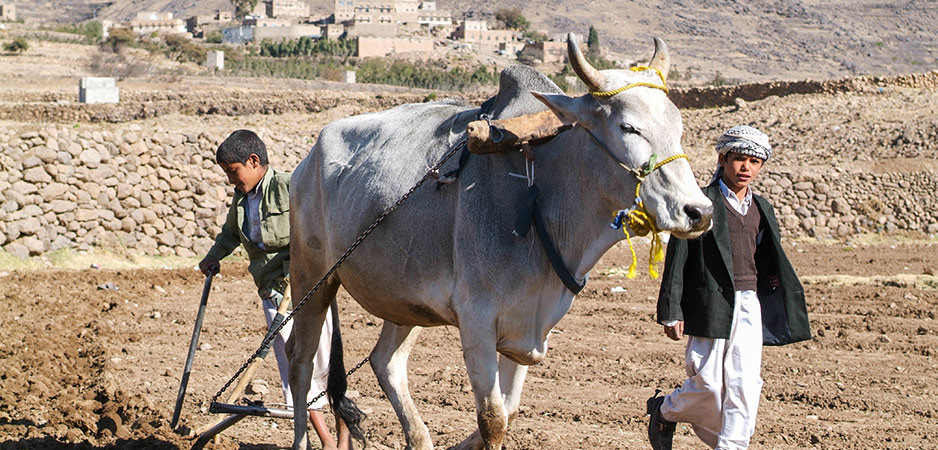Yemen’s food crisis is not different in its nature from other regions of the Arab world and the agrarian south more broadly. However, it is a severe case, hence the warning issued a year ago by the United Nations that Yemen, along with other countries, faces the imminent threat of famines of “biblical proportions.” The mass starvation that has engulfed the country is partly a consequence of the ongoing conflict, especially the economic blockade imposed in 2015. Yet the root causes predate the civil war, as devastating as it has been, and have only been revealed and exacerbated by it. At its core, Yemen’s food emergency is an agrarian and a rural social crisis that has been in the making since the formation of the two republics in the 1960s.
It is difficult to understand how a country of experienced farmers, extensively terraced areas and fertile agricultural valleys could fail to feed itself. In 1955, a mission of the Food and Agriculture Organization of the United Nations to Yemen concluded that it was one of the best terraced countries in the world at the time. Indeed, Yemeni farmers are worthy of being described as masters of their particularly harsh environment. The main features of Yemen’s geography and climate are seasonal rains in limited parts of the country and almost no precipitation elsewhere; semidesert coastal plains; western and central steep, rugged highlands of a volcanic mountain massif; and eastern and northeastern arid plateaus and vast deserts, including al-Rub’ al-Khali, literally the “Empty Quarter” — “the largest area of continuous sand in the world.”
What Caused Yemen’s Famine?
But despite the fragility of the Arabian Peninsula’s environment, including its southwestern corner, the ingenuity of Yemeni farmers’ methods has successfully established innovative and truly sustainable systems of agriculture and food production since time immemorial. As it turns out, what has thrown Yemen into a downward spiral of rural marginalization and impoverishment is an insidious alliance between irresponsible, short-sighted governance and a reckless global food regime, one that is obsessed with the bottom line and market value. Together, as Utsa Patnaik and Sam Moyo write in “The Agrarian Question in the Neoliberal Era: Primitive Accumulation and the Peasantry,” they worked to “reinforce the incorporation of the peasantry into volatile world markets and extend land alienation, while increasing import dependence.”
Once Yemen was hooked on “speculative world markets dominated by monopoly finance capital,” the rest of the damage was automatic. In fact, that is how free markets work, if that is what you feed into them. Yemen is a good case in point for malintegration with the global economy and the imposition of unequal agricultural trade at the expense of both food security and sovereignty.
Of Donkeys and Farmers
There are two main drivers of Yemen’s persistent and severe food insecurity. Both of them were simultaneously brought about by developmental interventions in the country, particularly in what is commonly referred to as northern Yemen. This part of the country is home to a major water-shed infrastructure spanning two fundamental food-producing systems: the mountain highlands and the lowland Yemeni Tihamah, the Red Sea coastal plain.
The first and foremost driver of insecurity is the large loss of domestic production of native staple grains, including, above all, sorghum. Called in Yemen, sorghum is an important traditional staple for humans and livestock. As pointed out by Daniel Varisco in his study of agriculture and water rights in Yemen, sorghum is boiled to make Yemeni porridge, , a nutritious popular dish, and ground to make flour for baking traditional bread. Sorghum leaves and stalks are fed to cattle, the bottom part of the stalk is used as fuel for a traditional clay oven, , and the surplus of sorghum fodder and grain is stored for the rest of the year (it is a summer crop, planted in late spring).
This loss is the direct result of the agricultural trade liberalization of the country’s local markets that was indirectly dictated to Yemen. It was done in the name of development, of course, by luring the country into artificially low prices for basic commodities on global markets. In her review of Samir Amin’s writing and ideas, Ingrid Harvold Kvangraven underscores that external dictates such as those imposed on Yemen have prioritized the demands of international capital over the long-term needs of the people. She adds that states, capitalists and non-capitalists alike, “need to invest not just in the goods that are the most immediately profitable on the world market or domestically, but in long-term projects that are the most likely to lead to improvements in living standards for people.”
As a consequence, Yemen became absurdly overdependent on basic foodstuff imports, including, notably, wheat and rice, from volatile world markets. In addition to leading to the country’s alarming state of hunger, the loss of domestic production has eventually resulted in a significant decrease in rural sustainability and livelihood. The domestic production figures speak for themselves. According to the Food and Agriculture Organization Corporate Statistical Database (FAOSTAT), Yemen produced between 700,000 and 760,000 tons of sorghum during the early 1960s. In 1960, the country’s population was 5.3 million. In sharp contrast, by 2014, one year before the start of the war, the quantity dropped to less than half, 341,000 tons, and then to 222,000 and 162,000 tons in 2015 and 2016 respectively.
By that time, the population had grown to an estimated 27.2 million. Meanwhile, the country’s net domestic supply quantity of wheat, for instance, went from an average of 115,222 tons for the period 1961–69 to 3,104,625 tons between 2010 and 2017. Similarly, the average domestic supply quantity of rice went from 20,333 tons to 533,250 tons for the same periods. Given that Yemen does not grow rice and almost entirely imports wheat, these figures portray Yemen’s rapid and costly transformation from food self-sufficiency to striking food insecurity.
Capturing the essence of the collapse of Yemen’s agriculturally self-sufficient economy is the shrewd observation by a professor of political philosophy at the University of Sanaa that donkeys and smallholding agriculturalists in Yemen share the same fate. Originally published in 1988, Abu Bakr al-Saqqaf’s analysis noted that lost donkeys that had been wandering the streets of the cities of Taiz, al-Hodeidah and Sanaa were dying of hunger or being killed by vehicles. Despite being an important agricultural asset, the animals were abandoned because their owners could no longer afford fodder. To deal with this problem, the Yemeni government borrowed money from the United States to supply fodder to local farmers instead of addressing the root cause of the problem.
The fate of the donkeys’ owners was no different. Coerced by the forces of the free market to abandon their agricultural lands altogether, they ended up wandering off en masse all the way to the Gulf, not just to urban Yemen. Previously dignified and accomplished farmers, Yemen’s smallholders and other rural male labor spent the rest of their working lives confined to small rooms they shared with other estranged comrades. Those who were better off lived in pathetic housing conditions in overpopulated and very poor parts of town. As such, Yemen’s peasantry was uprooted from the land, neither by chance nor by circumstances of their own making.
Draining Yemen’s Groundwater
The second driver of Yemen’s destitution is the major shift from longstanding rainfed agriculture to groundwater-dependent irrigated agriculture. It resulted from the introduction of hydraulic pumps powered by diesel in the country’s coastal region and dry plateaus, in addition to building expensive, high-maintenance barrages in the coastal spate-irrigated — Arabic for valleys, watercourses without a permanent flow of water — as documented by Martha Mundy and several others. These new irrigation methods and permanent diversion structures were perceived by international development agencies as technological improvements.
From their point of view, groundwater mining served to increase water supply for the production of crops that had a high international market value. Thus, in a capitalist economy, they were justified. However, by disregarding the country’s well-known water scarcity, those substantial investments served as a second blow to Yemen’s sustainable agriculture and rural productivity. Over-financed and unregulated, irrigated agriculture has overexploited and depleted Yemen’s deep fossil aquifers. It favored perishable yet lucrative crops destined for local urban and Gulf markets.
In so doing, it benefited the country’s large, wealthy and internationally connected landholders at the expense of its rural smallholders. In the short term, this market-oriented production policy impoverished the country’s rural population by freeing it from the land. In the long term, it starved the whole country, today home to an estimated 30 million people, by reinforcing its dependence on imported wheat and other staples. Reporting on the findings of his ecological field study of tribal farmers in al-Ahjur, a rich agricultural valley in the central highlands of Yemen, conducted in the late 1970s, Varisco concluded the following:
Many other informed experts have repeatedly cautioned that the injection of external agriculture technology and knowledge cripples Yemen’s development. In its report titled “Groundwater depletion clouds Yemen’s solar energy revolution” published in April, the Conflict and Environment Observatory issued yet another blunt warning. According to the report, solar power is “vital to break a crippling dependency on diesel for water supplies but it risks increasing unsustainable groundwater abstraction.” The report states that “urgent action is needed by all stakeholders to prevent groundwater levels falling to the point that they become inaccessible,” stressing that “the consequences of inaction may be dire.” They already are.
Regrettably, all alarms sounded over Yemen’s food insecurity and water insecurity have been deliberately ignored. The obvious dispossession, displacement and imprudent exploitation of agricultural assets, labor and resources under neoliberal conditionalities make it a foregone conclusion to state that Yemen’s famine is but a historic policy failure, as Patnaik and Moyo demonstrate in their book. In the words of Ali Kadri, “Yemeni labour and resources have to be continuously undermined and cheapened.” He explains: “The labouring classes in Yemen have to be denied control of their resources and readied to enter the global accumulation system as material of capital via its encroachment side.”
At any rate, agricultural policy in Yemen has commodified human life and dignity. Going forward, two things must change. First, Yemenis need to own their national development strategy. Second, the mainstream doctrines and attitudes toward the development of Yemen’s agriculture sector and the whole economy more broadly must change. In other words, postwar agricultural development policy must be both inward-looking and holistic. In agrarian societies, agriculture and rural production are integral to the whole economy. In the case of Yemen, a major change in agricultural policy that shifts away from ill-conceived neoliberal policies is inevitable, for they have not only silenced the interests of Yemen’s mostly rural population but famished the whole country.



